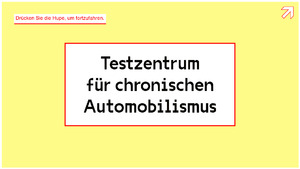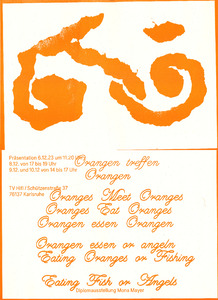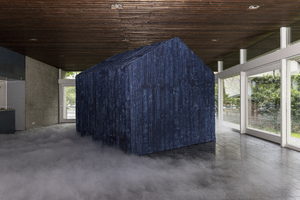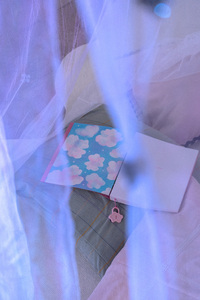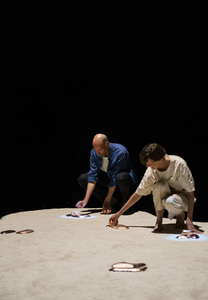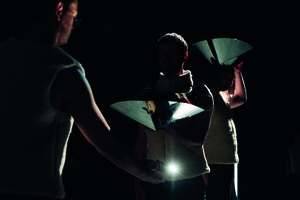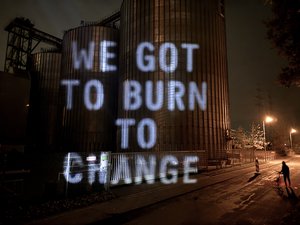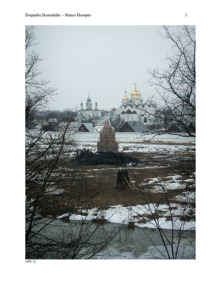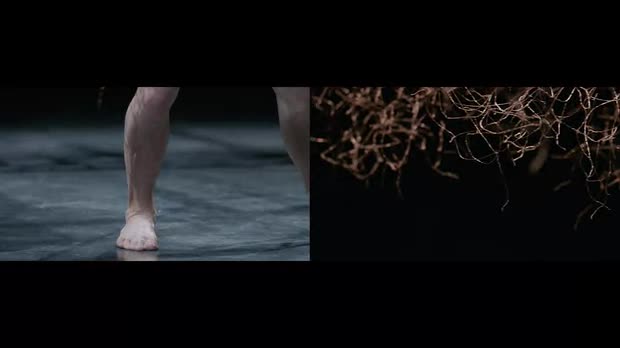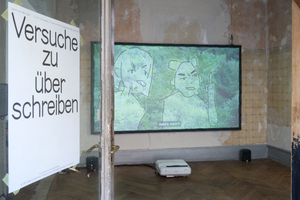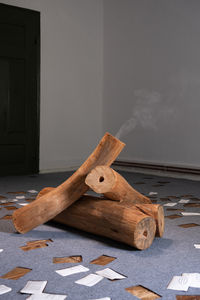Vakna
Benachbarte Sets (76)Alle Zusammenhänge anzeigen
Diese Sets wurden den gleichen Sets hinzugefügt wie das ausgewählte Set.
76 Inhalte
- Seite 1 von 7
Testzentrum für chronischen Automobilismus
- Titel
- Testzentrum für chronischen Automobilismus
- Autor/in
- Beschreibung (de)
- Radweg Ende, kein Zebrastreifen, Parkplatz voll, Bahn verpasst and stop and go, jemand hupt alle schauen, rote Ampel niemand da, falsch abgebogen, Licht vergessen, vollgas Lichthupe, Überholmaneuver trotz Geschwindigkeitsbegrenzung, ups! Personenschaden, Spiegel abgebrochen, Fenster runter „Arschloch!“, selber! Brumm. Kennen Sie das?
Verkehr ist eine höchst emotionale Angelegenheit. Die vielen kleinen Entscheidungen, die wir im automobilen Individualverkehr treffen müssen, sind immer auch mit einem Risiko behaftet. Sehen wir den "Personenschaden" als Katastrophe an, so müssen wir doch zugeben, dass auch die kleinen Fehlentscheidungen für Stress, Frust und Wut sorgen können. Ebendiese Reaktionen möchten wir im Kontext der sogenannten Mobilitätswende anerkennen, attestieren und aus ihnen Forderungen ableiten, die wir gerne für unsere Besucher*innen an die lokalen Behörden weiterleiten.
Auto, Fahrrad, Zufuß? Egal! Unsere 20-minütige Erstuntersuchung richtet sich an alle Verkehrsteilnehmer*innen. Erfahren Sie fachkundige Beratung und die Anwendung neuester Technologie. Tipp: Buchen Sie schon jetzt einen Termin und vermeiden Sie Wartezeiten. Wir freuen uns auf ihren Besuch!
- Radweg Ende, kein Zebrastreifen, Parkplatz voll, Bahn verpasst and stop and go, jemand hupt alle schauen, rote Ampel niemand da, falsch abgebogen, Licht vergessen, vollgas Lichthupe, Überholmaneuver trotz Geschwindigkeitsbegrenzung, ups! Personenschaden, Spiegel abgebrochen, Fenster runter „Arschloch!“, selber! Brumm. Kennen Sie das?
- Kategorie
- Typ des Projekts/Werks
- Schlagworte
- Datierung
- 25.03.2024 - 28.03.2024
- Mitwirkende
- Sprache
- Material
- Technik/Verfahren/Formate
- GameMaker Studio 2 (Game)
- Abmessungen
- 5 x 7,5 m
- Dauer
- 25 Minuten (Erstuntersuchung)
- Ort: Institution
- Stadt
- Land
- Internetlinks
- Bemerkungen
- Dank an: Alexander Knoppik, Alexander Thelen, Anna Haas (Badisches Staatstheater), Astrid Lindner-Maier, Barbara Kuon, Charlotte Singer, Christian Platz, Cornelia Herzog, Daniel Heiss (ZKM), Dario Schmid, Emelie Schreiner, Felix Fisgus, Franzi Wentz, Isabelle Schneider, Julian Kuf, Laura Richter, Leonie Mühlen, Martin Mangold (ZKM), Marvin Uhde (cant-deci.de), Max Bernhard, Miri, Omni-Mobil GmbH, Paula Schacke (die Anstoss e.V.), Pavel Polenz, Ralph Saam (Scheck-In Center Durlach), Richard Brunner, Sebastian Schäfer, Sebastian Schillbach, Sebastian Schönfeld, Silke Roth (die Anstoss e.V.), Susanne Henneberger (WERKRAUM: Karlsruhe e.V.), Susanne Schmitt, Sven Krahl, Timothée Charon, Tobias Keilbach, Tjark Schönfeld, Ute Wienberg (Badisches Staatstheater), Vlado Petrovic, Waldemar Schwab, Yun-Wen Liu
- Dank an: Alexander Knoppik, Alexander Thelen, Anna Haas (Badisches Staatstheater), Astrid Lindner-Maier, Barbara Kuon, Charlotte Singer, Christian Platz, Cornelia Herzog, Daniel Heiss (ZKM), Dario Schmid, Emelie Schreiner, Felix Fisgus, Franzi Wentz, Isabelle Schneider, Julian Kuf, Laura Richter, Leonie Mühlen, Martin Mangold (ZKM), Marvin Uhde (cant-deci.de), Max Bernhard, Miri, Omni-Mobil GmbH, Paula Schacke (die Anstoss e.V.), Pavel Polenz, Ralph Saam (Scheck-In Center Durlach), Richard Brunner, Sebastian Schäfer, Sebastian Schillbach, Sebastian Schönfeld, Silke Roth (die Anstoss e.V.), Susanne Henneberger (WERKRAUM: Karlsruhe e.V.), Susanne Schmitt, Sven Krahl, Timothée Charon, Tobias Keilbach, Tjark Schönfeld, Ute Wienberg (Badisches Staatstheater), Vlado Petrovic, Waldemar Schwab, Yun-Wen Liu
- Titel
- Testzentrum für chronischen Automobilismus
- Projektleiter/in
- Semester
- Studiengang
- Typ der Abschlussarbeit
- Importiert am
- 31.05.2024
- Übergeordnete Sets
- 2
- Set enthält
- 0 16
Eating Fish Or Angels
- Titel
- Eating Fish Or Angels
- Titel (en)
- Eating Fish Or Angels
- Autor/in
- Beschreibung (de)
- Eating Fish Or Angels umgreift Objekte, Aktionen, Performances
und Installationen, die in einem Prozess von 10 Monaten gesammelt und abschließend in einer Installation zusammengeführt wurden.
Inhalten, Medien und Ephemera aus dem Alltag in der Rolle als Kommunikationsdesignerin werden mit Abstand betrachtet, um sich mit neuem Blick und künstlerischen Mitteln wieder anzunähern. Die darin entstehenden inhärente Rituale, Logiken und Erzählstrukturen erkunden die Grenzen produktiver und unproduktiver, sinnvoller und sinnloser Tätigkeit, sowie verschiedener
Disziplinen, Identitäten und Strukturen.
- Eating Fish Or Angels umgreift Objekte, Aktionen, Performances
- Beschreibung (en)
- Eating Fish Or Angels encompasses objects, actions, performances
and installations that were collected over a period of 10 months and finally brought together in an installation.
Content, media and ephemera from everyday life in her role as a communication designer are viewed from a distance in order to approach them again with a new perspective and artistic means. The inherent rituals, logics and narrative structures that emerge explore the boundaries of productive and unproductive, meaningful and meaningless activity, as well as different disciplines, identities and structures.
- Eating Fish Or Angels encompasses objects, actions, performances
- Kategorie
- Mitwirkende
- Sprache
- Material
- Technik/Verfahren/Formate
- Multimediale Installation, Aktionen, Performances, Ausstellungen, Wortspiele, Sammeln, Archivieren
- Dauer
- Januar bis Oktober 2024 (Prozesszeitraum)
- Titel
- Eating Fish Or Angels
- Projektleiter/in
- Semester
- Studiengang
- Typ der Abschlussarbeit
- Importiert am
- 01.11.2024
- Übergeordnete Sets
- 1
- Set enthält
- 4 1
“I see” “with my voice”
- Titel
- “I see” “with my voice”
- Autor/in
- Beschreibung (de)
- „I see“ „with my voice“ beschäftigt sich mit Themen wie Transformation, Gestaltwandel und Materialität durch ein Zusammenspiel von literarischen Fragmenten und entliehenen Stimmen. Das Ergebnis ist eine nicht-lineare, fluide Erzählung, die die flüchtige Natur von Visionen, Träumen und Metamorphosen einfängt.
- Beschreibung (en)
- “I see” “with my voice” engages with themes of transformation,
shapeshifting, and materiality through an interplay of literary
fragments and borrowed voices, resulting in a non-linear, fluid
narrative that encapsulates the ephemeral nature of visions,
dreams, and metamorphoses.
This project draws substantial inspiration from Alice Notley's
The Descent of Alette, a transformative odyssey that employs
rhythmic spoken language to explore continuous change.
Alongside Notley’s influence, the works of Hildegard von Bingen,
a 12th-century mystic, and the visionary narratives from the
biblical book of Ezekiel, serve as foundational texts that inform
the thematic and structural framework of this piece.
The text is presented as an audio recording, whispered as a 20 minute loop.
Visitors can listen to the piece when pressing their ear against the tents walls.
My objects are performers, maybe even imposters: frozen in a state of change or mimicry. My objects are performers, maybe even imposters: frozen in a state of change or mimicry.
They are skillfull imitators, but you can tell something is off.
Moving along this crack between the believable and the not quite right, I like to engage
with different realities and states of being. The artificial, almost real-life fakeness of their with different realities and states of being. The artificial, almost real-life fakeness of their
surfaces set the stage for my narrative of transformation, imitation and shapeshifting.
1. A wooden house crafted from smooth denim. Made by sanding the grain of wood
onto the denim fabric
2. Heavy fog covering the floor that could be perceived as dew, mixed with a light subtle
smoke of Incense burning.
The fragrance envokes sacred, holy feelings with its warm, resinous smell with peppery The fragrance envokes sacred, holy feelings with its warm, resinous smell with peppery
undertones.
3. 100 cherries made from a thick mixture of honey and almonds. The heavy sweetness
of the stoneless candy-imposter meant to linger in the visitors mouth as it is tasted. of the stoneless candy-imposter meant to linger in the visitors mouth as it is tasted.
A thin gelatine film – imitating the coolnes of cherry skin as it touches the lips A thin gelatine film – imitating the coolnes of cherry skin as it touches the lips
The installation is accompanied by a small reader containing the three part text to be taken The installation is accompanied by a small reader containing the three part text to be taken
home and serve as a keep sake or document of the fleeting spoken text.
The reader is bound with one simple staple. It does not have a beginning or end, but The reader is bound with one simple staple. It does not have a beginning or end, but
rather works like a gif. No cover or back. Just like wheels turning endlessly in a nonlinear rather works like a gif. No cover or back. Just like wheels turning endlessly in a nonlinear
storytelling.
- “I see” “with my voice” engages with themes of transformation,
- Kategorie
- Typ des Projekts/Werks
- Schlagworte
- Datierung
- 18.04.2024
- Sprache
- Ort: Institution
- Ort
- “I see” “with my voice” at ZKM Pavillon, Karlsruhe
- Stadt
- Land
- Titel
- “I see” “with my voice”
- Projektleiter/in
- Semester
- Studiengang
- Typ der Abschlussarbeit
- Importiert am
- 19.09.2024
- Übergeordnete Sets
- 0
- Set enthält
- 0 2
eternal girlhood
- Titel
- eternal girlhood
- Untertitel
- oh my dreams
- Autor/in
- Beschreibung (de)
- “eternal girlhood” ist eine konzeptionelle Arbeit, welche aus einer Rauminstallation und einer Publikation besteht.
Ursprünglich in den Chinesischen Pavillons des Fasanengarten in Karlsruhe installiert, wurden durch Requisiten sowie einem selbst produzierten Musikstück, der Raum mit der Handlung der Publikation, verknüpft.
Das Projekt ermöglicht eine Reise in eine poetische Geschichte, inspiriert von persönlichen und kulturellen Themen wie Girlhood, Coming-of-Age und Growing Pains.
Die Handgebundene Publikation mit glitzerndem und geprägtem Umschlag umfasst auf ca. 100 Seiten neben Serien Analoger Schwarzweiß-Fotografie farbige Mittelformat Fotos, begleitet von analogen Schnappschüssen und Riso gedruckte Illustrationen.
Zwischen Fotoserien und Illustrationen, sind Songtexte sowie Skript-fragmente und Gedichte eingestreut, in Referenz zu Filmsequenzen aus Coming of Age Geschichten. Es ergibt sich die zeitlose Skizze eines Mädchens die Teil einer innig verbundenen Mädchengruppe ist.
Transparente Drucke von drei Mittelformat Fotografien werden vom Fensterlicht erleuchtet und symbolisieren in Zusammenarbeit mit dem Buch unterschiedliche Kapitel der Geschichte.
Unter einem Baldachin, umgeben von funkelnd tanzenden Schmetterlingen können Besucher*innen in diese Welt eintauchen und sind eingeladen, für einen Moment Teil von „eternal girlhood“ zu sein, fernab der Echtzeit.
- “eternal girlhood” ist eine konzeptionelle Arbeit, welche aus einer Rauminstallation und einer Publikation besteht.
- Beschreibung (en)
- “eternal girlhood“ is a conceptional Artwork, blending a publication with its installation space.
Initially installed in the Chinese pavillons of the Fasanengarten in Karlsruhe, the space was connected to the story of the book through props and a musical sound score.
The project offers a journey into a poetic Story, inspired by personal and cultural ideas on girlhood, coming of age and growing pains.
Handbound, wrapped in a glittery embossed Dustcover, the Publication features around 100 Pages with multiple series of black and white film photography, medium format shots underlined by analog snapshots and Riso printed Illustrations. In between the Chapters of Photography and Illustrations, lyrics, fragments of script and poems are inserted in reference to movie sequences from coming of age stories. A timeless profile of a girl being part of girlhood and a deeply connected friendship is created.
Transparent prints of three medium format photos are illuminated by the windows’ natural light and symbolize different chapters of the story in collaboration with the book.
Underneath a canopy, surrounded by sparkling dancing butterflies, Visitors can dive into this World and are invited to become part of “eternal girlhood“, away from modern reality.
- “eternal girlhood“ is a conceptional Artwork, blending a publication with its installation space.
- Kategorie
- Typ des Projekts/Werks
- Schlagworte
- Datierung
- 05.07.2024
- Mitwirkende
- Dank an
- Sprache
- Material
- Technik/Verfahren/Formate
- Risographie Druck, Digitaldruck, Mediumformat Fotografie, Schreibmaschine, Laser, Prägung
- Abmessungen
- Fläche: ca. 5m x 5m, Höhe der Aufhängung ca. 3m
- Ort: Institution
- Ort
- Chinesische Pavilions des Fasanengarten
- Stadt
- Land
- Beteiligte Institution(en)
- Titel
- eternal girlhood
- Projektleiter/in
- Studiengang
- Typ der Abschlussarbeit
- Importiert am
- 05.11.2024
- Übergeordnete Sets
- 1
- Set enthält
- 0 21
finding traces and placing connections
- Titel
- finding traces and placing connections
- Autor/in
- Beschreibung (de)
- „finding traces and placing connections“ ist eine interaktive Kunstinstallation und ein persönlicher Liebesbrief an das Material Kupfer. Die Arbeit zelebriert die Funktionalität, Vielseitigkeit und Schönheit des Kupfers.
Besucher*innen können die in den Teppich eingelassenen Kupferflächen durch fünf verkupferte Steine verbinden und kontrollieren dadurch Klang und Licht des Raumes.
Die Komposition für das Werk wurde aus Aufnahmen, die durch Interaktion mit Kupferobjekten entstanden sind, generiert.
Jede aktivierte Fläche leuchtet auf und fügt eine Audiospur zur Komposition hinzu.
Dadurch entsteht nicht nur eine Interaktion mit der Arbeit, sondern auch eine Interaktion zwischen den Besucher*innen. Durch das Zusammenspiel entstehen individuelle Kompositionen und Kombinationen der Audiospuren und immer neue Abwandlungen des Klanges.
„finding traces and placing connections“ lädt ein, zu entdecken, zu hören.
- „finding traces and placing connections“ ist eine interaktive Kunstinstallation und ein persönlicher Liebesbrief an das Material Kupfer. Die Arbeit zelebriert die Funktionalität, Vielseitigkeit und Schönheit des Kupfers.
- Beschreibung (en)
- “finding traces and placing connections” is an interactive art installation and a personal love letter to the material copper. The work celebrates the functionality, versatility and beauty of copper.
Visitors can connect the copper surfaces embedded in the carpet with five copper-plated stones and thereby control the sound and light of the room.
The composition for the work was generated from recordings made through interaction with copper objects.
Each activated surface lights up and adds an audio track to the composition.
This not only creates an interaction with the work, but also an interaction between the visitors. The interplay creates individual compositions and combinations of audio tracks and ever new variations of the sound.
“finding traces and placing connections” invites you to discover and listen.
- “finding traces and placing connections” is an interactive art installation and a personal love letter to the material copper. The work celebrates the functionality, versatility and beauty of copper.
- Kategorie
- Typ des Projekts/Werks
- Schlagworte
- Datierung
- Juni 2024
- Mitwirkende
- Dank an
- Material
- Abmessungen
- 4m x 5m
- Ort: Institution
- Titel
- finding traces and placing connections
- Projektleiter/in
- Semester
- Studiengang
- Typ der Abschlussarbeit
- Importiert am
- 05.11.2024
- Übergeordnete Sets
- 3
- Set enthält
- 0 23
Reflecting Bodies
- Titel
- Reflecting Bodies
- Titel (en)
- Reflecting Bodies
- Untertitel
- A space where a physical phenomenon meets a personal fascination
- Untertitel des Projekts/Werks (en)
- A space where a physical phenomenon meets a personal fascination
- Autor/in
- Beschreibung (de)
- „Reflektierende Körper“ ist eine interaktive Installation, bei der das physikalische Phänomen der Lichtreflexionen auf eine persönliche Faszination für diese trifft. Im Fokus stehen Lichtreflexionen, die vom menschlichen Körper ausgehen und in Verbindung mit dessen Bewegungsabläufen entstehen.
Hauptbestandteil der Installation ist eine Serie von vier Metallobjekten, die wie Schmuckstücke am Körper getragen werden und mit Wasser gefüllt sind. Sie dienen als Reflexionsflächen und geben auf subtile Art und Weise die Präsenz der Menschen im Raum wieder, während sich dieser in eine lebendige und dynamische Lichtinstallation verwandelt.
Ursprung der Arbeit ist die Auseinandersetzung mit dem Thema "natürliches Licht" und dessen Bedeutung für den Menschen. Die allgemeine Faszination und evolutionsbedingte Abhängigkeit der Menschheit von der Sonne findet sich in nahezu allen Kulturen wieder und bildet die Inspirationsquelle für die Formensprache der Objekte und die Gestaltung des Raums.
- „Reflektierende Körper“ ist eine interaktive Installation, bei der das physikalische Phänomen der Lichtreflexionen auf eine persönliche Faszination für diese trifft. Im Fokus stehen Lichtreflexionen, die vom menschlichen Körper ausgehen und in Verbindung mit dessen Bewegungsabläufen entstehen.
- Beschreibung (en)
- "Reflecting Bodies" is an interactive installation in which the physical phenomenon of light reflections meets a personal fascination for them. The focus is on light reflections that originate from the human body and arise in connection with its movements.
The main component of the installation is a series of four metal objects worn like jewellery pieces on the body and filled with water. They serve as reflecting surfaces and subtly mirror the presence of people in space while it transforms into a vibrant and dynamic light installation.
The origin of the work lies in the study of natural light and its importance for human beings. The general fascination and evolutionary dependence of mankind on the sun can be found in almost all cultures and forms the source of inspiration for the design language of the objects and the space.
- "Reflecting Bodies" is an interactive installation in which the physical phenomenon of light reflections meets a personal fascination for them. The focus is on light reflections that originate from the human body and arise in connection with its movements.
- Kategorie
- Typ des Projekts/Werks
- Schlagworte
- Datierung
- 27.04.2023
- Mitwirkende
- Dank an
- Material
- Technik/Verfahren/Formate
- Metallverarbeitung
- Ort: Institution
- Ort
- Großes Studio
- Stadt
- Land
- Internetlinks
- Titel
- Reflecting Bodies
- Projektleiter/in
- Semester
- Studiengang
- Typ der Abschlussarbeit
- Importiert am
- 06.10.2024
- Übergeordnete Sets
- 2
- Set enthält
- 0 9
Letters of Dissent
- Titel
- Letters of Dissent
- Titel (en)
- Letters of Dissent
- Autor/in
- Beschreibung (de)
- Mein Diplomprojekt mit dem Titel „LETTERS OF DISSENT“ hatte zum Ziel, praktische und zugängliche Mittel des nächtlichen Protests zu erforschen. Dieses Projekt, das sich mit der Wechselbeziehung von Geschichtenerzählen und Punk-Einflüssen befasst, soll durch künstlerische Intervention ein Schlaglicht auf soziale und politische Themen werfen. Es handelt sich um selbst geschriebene Erzählungen, die in einer auf optimale Lesbarkeit ausgelegten Schriftart verfasst sind. Die Einfachheit der verwendeten Technik sorgt für Tragbarkeit und Zugänglichkeit. Das Engagement der Gemeinschaft ist integraler Bestandteil des Werks, das sowohl als Lasercut- als auch als 3D-Druckversion vorliegt und als Open-Source-Initiative zur Verfügung gestellt wird. Die Gesamtästhetik ist von auffallender Helligkeit geprägt und schafft eine visuell beeindruckende und deutlich wahrnehmbare Präsenz. Neben der Hauptdiplomarbeit ist es erforderlich, neuere Arbeiten in einer Ausstellung zu präsentieren, in der sorgfältig ausgewählte Projekte vorgestellt werden. In dem Bemühen, das Ausstellungsdesign auf das übergreifende Thema des Diplomprojekts abzustimmen, zielte der Designansatz darauf ab, wesentliche Prinzipien wie Zugänglichkeit, Abfallminimierung und eine ephemere Pop-up-Sensibilität zu verkörpern.
- Beschreibung (en)
- My diploma project titled "LETTERS OF DISSENT," aimed to explore practical and approachable means of protesting during the nighttime. Delving into the interrelation of storytelling and punk influence, this project seeks to cast a spotlight on social and political subjects through artistic intervention. It involves self-written narratives, utilising a font designed for optimal readability. The simplicity of the technique employed ensures portability and accessibility. Community engagement is integral, using both a lasercut and 3D-print version of the work, which is made available as an open-source initiative. The overall aesthetic is marked by striking brightness, creating a visually impactful and overtly noticeable presence. In addition to the primary diploma project, it is required to showcase recent works in an exhibition, featuring carefully chosen projects. In an effort to align the exhibition design with the overarching theme of the diploma project, the design approach aimed to encapsulate essential principles such as accessibility, waste minimisation, and an ephemeral, pop-up sensibility.
- Kategorie
- Schlagworte
- Datierung
- 03.11.2023
- Titel
- Letters of Dissent
- Projektleiter/in
- Semester
- Studiengang
- Typ der Abschlussarbeit
- Importiert am
- 30.10.2024
- Übergeordnete Sets
- 3
- Set enthält
- 0 11
Ephemeral Antipodes
- Titel
- Ephemeral Antipodes
- Titel (en)
- Ephemeral Antipodes
- Autor/in
- Beschreibung (de)
- "Ephemeral Antipodes" ist eine interaktive, Raum einnehmende Klanginstallation. Die Adern der elektronischen Welt, simple Stromkabel, wachsen zu Kupferskulpturen heran. Aufgrund menschlichen Handelns erzeugen analoge Bauteile auf Platinen den Klang und fragile, in Ton gefasste Lautsprecher brechen unter der Last ihrer eigenen Resonanz zusammen. Durch den schmalen Eingang betritt man einen nur spärlich beleuchteten Raum. Seine Wände verschwinden in der Dunkelheit und erzeugen die Illusion einer grenzenlosen Tiefe.
Es lässt sich nur schemenhaft ein metallisch glänzender Wald aus nadelbaumartigen, schwebenden Adern ausmachen. Meterlange, versetzt angebrachte Skulpturen entflochtener Kupferkabel nehmen das komplette erste Drittel des Raumes ein. Die einzelnen Kabeläste hängen so eng nebeneinander, dass beim Versuch hindurchzukommen sich zwangsläufig Kabel berühren. Wegen der Leitfähigkeit des Kupfers wird durch den Kontakt von Ast zu Ast ein Kreislauf geschlossen, ein Schalter aktiviert und ein spezifischer Signalton generiert.
Die Impulsenergie, der Mensch, als Auslöser zur Systemveränderung. Der Klang wirkt dissoziativ, da die Lautsprecher erst nach dem Durchschreiten des Kupferwaldes am anderen Ende des Raumes sichtbar werden. Da jeder Kupferast einzeln und beweglich aufgehängt ist, kann dadurch wie bei einem newtonschen Pendel der Stoß der Bewegung zu einer Kettenreaktion führen und damit ein überraschender Signalton-Noise entstehen. Die Stränge variieren leicht in ihrem Frequenzbereich, wodurch eine Bandbreite an Tönen hörbar gemacht werden kann, wenn man bewusst den kompletten Raum des Kupferdraht-Dickichts mit seinem Hindurchschreiten in Bewegung versetzt. Am anderen Ende des Kupferwaldes türmen sich organisch anmutende Keramik-Gefäße zu einem hohen Berg auf, in denen die Klang wiedergebenden Lautsprecher eingebaut sind. Der Ton wird durch die Wahl der organartigen, in ihren Größen stark abweichenden Keramikhüllen verzerrt wiedergegeben. Teil des Konzeptes ist, dass die naturfarbenen Gehäuse nur einmal gebrannt oder luftgetrocknet werden, um Risse oder ein Zerbrechen durch
Klangvibrationen zu provozieren.
Ein langsamer Zerfall des hohen Klang-Geschwürs. Zwischen Wald und Berg ist die Distanz bewusst gewählt. Es ist dadurch entweder möglich, Klang zu erzeugen oder sich die Gefäße im Detail anzuschauen.
Doch zur vollkommenen Ruhe kommt es beim Ausbleiben der Interaktion mit dem Noise Wald nicht. Grob nach der Zeitspanne eines unscharf werdenden Blicks hin zum Fokus auf den eigenen inneren Monolog, brodelt ein anschwellender tiefer, körperlich spürbarer Basston durch den Raum. Monotonie bei Stillstand, die in ihrer Vorhersehbarkeit des immer gleichen meditativen Tieftons etwas beruhigendes hat. Doch je tiefer die Tonfrequenz, desto stärker wird die Vibration des Lautsprecher-Schalls. Durch die vom Stillstand ausgelöste Bass-Monotonie nimmt das Risiko der Zermürbung des Ton-Geschwürs dramatisch zu.
Die Raum-Atmosphäre ändert sich. Der tiefe Klang wird körperlich spürbar und das Risiko der Zermürbung der Gefäße nimmt deutlich zu.
Die eigene Wahrnehmung an der Grenze zum Kurzschluss. Konsequenzen solcher Entscheidungen führen zu unvorhersehbaren Kettenreaktionen.
Eine überfordernde Echtzeit-Simulation des möglichen Handelns ohne Ergebnis und Ideallösung.
Ursache und Wirkung – gegenseitig provozierende Katalysatoren, die sich von monotoner Routine in unreflektierte Impulsivität steigern.
Die Arbeit ist ein Ort, der einem periphere Emotionen wieder vor Augen führt.
Ein Experiment über Wahrnehmung und Reizbarkeit.
Eine Simulation zwischen Kontrolle und Grenzüberschreitung, die in ihrer Überstimulanz und dem daraus folgenden Kollaps ein mögliches Ende findet.
Performance von Kiesecker-Hoess.
Im Juli 2023 wurde "Ephemeral Antipodes" mit dem Preis der Heinrich-Hertz-Gesellschaft durch die Fördergesellschaft ZKM / HfG e.V. ausgezeichnet.
- https://hfg-karlsruhe.de/archiv/hfg-studierende-du…
- https://www.schroff-stiftungen.de/preistraeger-der…
Shortlist Nominierung “Beste Abschlussarbeit” durch den Fachbereich Medienkunst für die Preise der Fördergesellschaft ZKM / HfG e.V. 2023
- https://hfg-karlsruhe.de/projekte-rundgang-2023/ep…
Großes Studio der Staatlichen Hochschule für Gestaltung Karlsruhe 2023
- https://hfg-karlsruhe.de/archiv/eroeffnung-der-aus…
- "Ephemeral Antipodes" ist eine interaktive, Raum einnehmende Klanginstallation. Die Adern der elektronischen Welt, simple Stromkabel, wachsen zu Kupferskulpturen heran. Aufgrund menschlichen Handelns erzeugen analoge Bauteile auf Platinen den Klang und fragile, in Ton gefasste Lautsprecher brechen unter der Last ihrer eigenen Resonanz zusammen. Durch den schmalen Eingang betritt man einen nur spärlich beleuchteten Raum. Seine Wände verschwinden in der Dunkelheit und erzeugen die Illusion einer grenzenlosen Tiefe.
- Beschreibung (en)
- "Ephemeral Antipodes" is an interactive and space-occupying sound installation. The veins of the electronic world, simple wires grow into copper sculptures. Analog components on circuit boards create the sound and speakers installed inside fragile clay bowls collapse under their own
resonance.
Through the narrow entrance, one enters a sparsely lit room. Its walls disappear into darkness, creating the illusion of endless depth. A shiny metallic forest of needle-like, floating veins can only be dimly distinguished. Staggered, meter-long sculptures of unbraided copper cables
take up the entire first third of the room. The individual cable branches hang so closely to one another that cables inevitably touch when one attempts to pass through them. Because of the copper's conductivity, contact from branch to branch closes a circuit, activates a switch, and generates a specific noise. The impulse energy, the human being, as a trigger to change the system. The sound has a dissociative effect, as the speakers only become visible after passing through the copper forest towards the other end of the room. Since each copper branch is individually and movable suspended, the shock of movement can thereby lead to a chain reaction, as in a Newtonian Pendulum, resulting in a surprising signal sound noise. The strands vary slightly in their frequency spectrum, allowing a range of tones to be made audible by consciously setting the entire space of the copper wire thicket in motion as one passes through.
Near the other end of the copper forest, organic-looking ceramic vessels pile up into a tall mountain, encasing the audio-reproducing loudspeakers. The sound is rendered distorted by the choice of organ-like ceramic skins, which vary significantly in size. Part of the concept is that the natural-colored casings are fired or air-dried only once to provoke cracking or shattering from sonic vibrations.
A slow decay of the tall noise ulcer. The distance between forest and mountain is deliberately chosen. Through this it is either possible to create sound or to look at the vessels in detail.
However, complete silence does not occur in the absence of interaction within the woods. Roughly after the time span of a blurring gaze towards the focus on one's own inner monologue, a swelling deep, physically sense-able bass tone simmers through the air.
Monotony at a standstill, there is something soothing in its predictability of the same meditative deep timbre over and over again. But the lower the frequency, the stronger the vibration gets of the resounding bass wave of the speakers.
Due to the monotony of the bass triggered by standstill, the risk of fracturing the sound tumor increases dramatically.
The mood of the atmosphere in the room changes. The deep sound becomes physically sensible and the risk of wearing down the vessels increases significantly.
One's own perception on the verge of short-circuiting, consequences of such decisions lead to unpredictable chain reactions.
An overwhelming real-time simulation of possible action without any result or an ideal solution.
Cause and effect – mutually provoking catalysts, which increase from monotonous routine into unreflected impulsivity.
"Ephemeral Antipodes" is a place that brings peripheral emotions front of mind again. An experiment on perception and irritability. A simulation between control and transgression, which finds a possible end in its overstimulation and its resulting collapse.
Performance by Kiesecker-Hoess.
Winner of the 2023 Heinrich-Hertz-Gesellschaft Price, honored by Fördergesellschaft ZKM / HfG e.V.
- https://hfg-karlsruhe.de/en/archiv/hfg-studierende…
- https://www.schroff-stiftungen.de/preistraeger-der…
Shortlist Nomination “Best Final Thesis” by the Department of Media Art for the prizes of the Fördergesellschaft ZKM / HfG e.V. 2023
- https://hfg-karlsruhe.de/en/projekte-rundgang-2023…
Großes Studio at Karlsruhe University of Arts and Design 2023
- https://hfg-karlsruhe.de/en/archiv/eroeffnung-der-…
- "Ephemeral Antipodes" is an interactive and space-occupying sound installation. The veins of the electronic world, simple wires grow into copper sculptures. Analog components on circuit boards create the sound and speakers installed inside fragile clay bowls collapse under their own
- Kategorie
- Typ des Projekts/Werks
- Schlagworte
- Datierung
- 02/03/2023
- Material
- Technik/Verfahren/Formate
- Kupfer, Platinen, Ton, Multi-Kanal Sound - Interaktive Klanginstallation, Kupferbaum (170 x 90 cm): aus 6m FLY B Kabel; 63 Stück, Kupferdraht, PVC Verkleidung Aufhängung (3 m): aus 6m FLY B Kabel Ummantelung; 63 Stück, Kabelbinder, PVC Verkleidung Verbindung Strom (verschiedene Längen): abgeschirmtes Kabel; 32 Stück, ca. 400 m Gesamtlänge Verbindung Erdung (ca 9 m): einfaches Kabel; 32 Stück, 290 m Gesamtlänge Sensorik Schalter und Klangerzeugung (40 x 65 cm): Platinen auf Acryl; 16 Stück, Leiterplatten, Bauteile Sensorik Drohne: Max Patch und Bewegungsmelder; Computer, Sensor, Verbindungskabel Ton-Lautsprecher (verschiedene Größen): Tongefäß und Lautsprechertreiber; Ca 95 Stück, ca 320kg Gesamtgewicht Weitere Technik: 6 x E8 Lautsprecher, 4 x 8-Kanal Verstärker, 2 x DI-Box, Mischpult, 10er Multicore XRL, diverse XLR-,Mehrfach- und Stromkabel Konstruktion Aufhängung Kupferbäume: Stangenkräne, Alu-Pipes, Doppelschellen, Traversen
- Abmessungen
- Bereich Bäume (63 Stück): 9m x 7m x 3,7m/ Bereich Ton-Berg (ca 95 Stück): 5m x 4m x 2m
- Ort
- Großes Studio, HfG Karlsruhe
- Stadt
- Land
- Internetlinks
- Titel
- Ephemeral Antipodes
- Projektleiter/in
- Semester
- Studiengang
- Typ der Abschlussarbeit
- Importiert am
- 03.12.2024
- Übergeordnete Sets
- 3
- Set enthält
- 0 28
Versuche zu überschreiben
- Titel
- Versuche zu überschreiben
- Titel (en)
- Attempts to rewrite
- Untertitel des Projekts/Werks (en)
- Exhibition with three video works: On the way to the station, Prologue: In the zoo, Germania Girl - Concert in the castle!
- Autor/in
- Beschreibung (de)
- Obszön, nerdy und aus Japan: Anime im Fernsehen zu schauen galt in vielen Haushalten in Deutschland als verrufen. Diese Rezeption von Anime entspricht zugleich den exotisierenden Stereotypen, die der (vorgeblich gesittete) Westen auf Japan projiziert. In ihrer Diplomarbeit nutzt Miki Feller Anime als Medium, um über anti-asiatischen Rassismus zu sprechen. Entstanden sind drei Videoarbeiten, die sie in ihrer Ausstellung „Versuche zu überschreiben“ gezeigt hat. Jedes Video erzählt eine eigene Geschichte, die in Karlsruhe spielt, unter anderem am Bahnhof, am Zoo und am Schloss. Es sind Versuche, eine vorherrschend weiße Umgebung zu beschreiben, sich dazu zu positionieren und davon zu distanzieren.
Die Videos wurden in Zusammenarbeit mit folgenden Personen realisiert und ausgestellt: „Versuche zu überschreiben“ mit Max Mandery (Dramaturgische Beratung), Bruno Jacoby (Grafik), Leia Walz (Ausstellungsgestaltung), Jaya Demmer (Textil), Johannes Thimm und Lina Determann (Rampe) / „Auf dem Weg zum Bahnhof“ mit Bruno Jacoby (Grafik) / „Prolog: Im Zoo“ mit Sophia Stadler (Storyboard, Schnitt & Fotos) / „Germania Girl – Konzert im Schloss!“ mit Max Mandery (Dramaturgische Beratung), Bruno Jacoby (Grafik), Yun-Wen Liu (Fotos & Farbkorrektur), Vanessa Bosch (Musik), Ricarda Fischer (Musik & Sounddesign), Meret Bhend und Paulina Mimberg (Farbkorrektur), Luise Peschko (Dialog Editing) sowie Nele Faust, Alejandra Janus, Melanie Berner, Rita Andrulyte, Nini Lü, Jörg Stegmann, Laura Haak und Josefine Scheu (Stimmen).
- Obszön, nerdy und aus Japan: Anime im Fernsehen zu schauen galt in vielen Haushalten in Deutschland als verrufen. Diese Rezeption von Anime entspricht zugleich den exotisierenden Stereotypen, die der (vorgeblich gesittete) Westen auf Japan projiziert. In ihrer Diplomarbeit nutzt Miki Feller Anime als Medium, um über anti-asiatischen Rassismus zu sprechen. Entstanden sind drei Videoarbeiten, die sie in ihrer Ausstellung „Versuche zu überschreiben“ gezeigt hat. Jedes Video erzählt eine eigene Geschichte, die in Karlsruhe spielt, unter anderem am Bahnhof, am Zoo und am Schloss. Es sind Versuche, eine vorherrschend weiße Umgebung zu beschreiben, sich dazu zu positionieren und davon zu distanzieren.
- Beschreibung (en)
- Obscene, nerdy, and from Japan: In many German households, it was forbidden to watch anime on television. This perception of anime mirrors the exoticizing stereotypes projected onto Japan by the (allegedly civilized) West. In her diploma project, Miki Feller addresses anti-Asian racism in Germany by using anime as the medium. She created three video works and showcased them in the exhibition “Versuche zu überschreiben.” Each video tells a story set in Karlsruhe, for example, at the train station, the zoo, and the castle. These videos serve as attempts to describe a predominantly white environment, to position oneself in relation to it, and to distance oneself from it.
The videos were created and presented in collaboration with the following people: "Versuche zu überschreiben" with Max Mandery (dramaturgical consultation), Bruno Jacoby (graphics), Leia Walz (exhibition design), Jaya Demmer (textile), Johannes Thimm and Lina Determann (ramp) / "Auf dem Weg zum Bahnhof" with Bruno Jacoby (graphics) / "Prolog: Im Zoo" with Sophia Stadler (storyboard, editing & photos) / "Germania Girl - Konzert im Schloss!" with Max Mandery (dramaturgical consultation), Bruno Jacoby (graphics), Yun-Wen Liu (photos & color grading), Vanessa Bosch (music), Ricarda Fischer (music & sound design), Meret Bhend and Paulina Mimberg (color grading), Luise Peschko (dialog editing) as well as Nele Faust, Alejandra Janus, Melanie Berner, Rita Andrulyte, Nini Lü, Jörg Stegmann, Laura Haak, and Josefine Scheu (voice acting).
- Obscene, nerdy, and from Japan: In many German households, it was forbidden to watch anime on television. This perception of anime mirrors the exoticizing stereotypes projected onto Japan by the (allegedly civilized) West. In her diploma project, Miki Feller addresses anti-Asian racism in Germany by using anime as the medium. She created three video works and showcased them in the exhibition “Versuche zu überschreiben.” Each video tells a story set in Karlsruhe, for example, at the train station, the zoo, and the castle. These videos serve as attempts to describe a predominantly white environment, to position oneself in relation to it, and to distance oneself from it.
- Typ des Projekts/Werks
- Schlagworte
- Datierung
- 22.09.2023 - 24.09.2023
- Mitwirkende
- Dank an
- Sprache
- Ort: Institution
- Stadt
- Land
- Titel
- Versuche zu überschreiben
- Projektleiter/in
- Semester
- Studiengang
- Typ der Abschlussarbeit
- Importiert am
- 04.03.2024
- Übergeordnete Sets
- 3
- Set enthält
- 0 9
The Plenum – A Scripted Play
- Titel
- The Plenum – A Scripted Play
- Autor/in
- Beschreibung (de)
- "The Plenum – A Scripted Play" behandelt das performative, das rituelle und das gemeinschaftsbildende Moment des Plenums als Planungstreffen selbstverwalteter Gruppen im politischen und kulturellen Kontext.
Über den Zeitraum eines Jahres wurden "Plena" in unterschiedlichen Konstellationen durchgeführt, die die gruppeneigene Dynamik untersuchten und auf Basis eines sich verändernden Scripts, einem Theaterdrehbuch oder Code gleichend, in einer kollektiven Performance Ausdruck fanden.
Die dabei von der Gruppe gemachten Erfahrungen dienten nicht nur zur Dokumentation für Gewesenes, sondern wurden als neuer „Input“ sofort in das bestehende Script eingearbeitet. Das sich permanent verändernde Projekt konnte so nach Vorbild eines Computerprogramms transparent gestaltet werden und ermöglichte eine basisdemokratische Beteiligung aller Akteur:innen – unabhängig von präexistentem Wissen oder Erfahrungswerten.
Nach Vorbild von Jo Freemans Essay „The Tyranny Of Structurelessness“ stand das Schaffen offener und klarer Kommunikation bezüglich der eigenen Gruppenstruktur und deren „Balance of Power“ im Mittelpunkt der Treffen.
„The Plenum – A Scripted Play“ ist jedoch nicht nur ein reales Treffen einer politischen Gruppe, sondern schafft seine identitäre Notwendigkeit durch seine Schnittstelle mit der Simulation: Das Finden von Mehrheiten (oder Einstimmigkeiten), die Verteilung von Macht und Autorität innerhalb der eigenen Gruppe sowie der Entscheidungsfindungsprozess wurden in verschiedenen Modellen spielerisch erprobt und in ihren politischen und historischen Kontext eingeordnet. Der fiktive Aspekt der Treffen öffnete Spielräume zur Reflexion über das eigene Verhalten innerhalb von Gruppengefügen. Vielen dieser Simulationen dienten Computercodes, Brettspiele und politische Verfassungen zur Vorlage.
Einem jeden Treffen selbstverwalteter Gruppen wohnt immer – oft unbewusst – etwas Rituelles inne, das zum Schaffen der kollektiven Identität von hoher Bedeutung ist. Das Wiederholen planerischer Abläufe und die kodifizierten, gruppenspezifischen Kommunikationsregeln entscheiden über Zugehörigkeit zur Gruppe und sind identitäts- und sinnstiftend.
Was vom Plenum bleibt, sind Simulationsskizzen, ein (beinahe) gegründeter Verein, eine intensive Auseinandersetzung um Vergütungsmodelle in einer nonmonetären Mikrowirtschaft und das Erarbeiten nachhaltiger Strukturen für die eigene kulturelle und politische Praxis, die sich bis heute fortsetzen. Sichtbar von alledem ist nichts, außer die Spuren, die wir stigmergisch hinterlassen.
Diese Spuren: Der Raum, in dem wir uns treffen; das Feuer, um das wir uns versammeln; die Karten, aus denen wir ablesen können, was einmal besprochen wurde – und werden wird; und das Script, ein sich permanent veränderndes Programm, das es uns vielleicht einmal ermöglichen wird, eine sozial und ökologisch nachhaltige Existenz in der Kunst- und Kulturszene zu führen.
- "The Plenum – A Scripted Play" behandelt das performative, das rituelle und das gemeinschaftsbildende Moment des Plenums als Planungstreffen selbstverwalteter Gruppen im politischen und kulturellen Kontext.
- Beschreibung (en)
- "The Plenum - A Scripted Play" deals with the performative, ritual and community-building moment of the plenum as a planning meeting of self-organised groups in a political and cultural context.
Over the course of a year, "Plena" were held in different constellations, which examined the group's own dynamics and found expression in a collective performance based on a changing script, similar to a theatre script or code.
The experiences made by the group not only served to document what had already happened, but were also immediately incorporated into the existing script as new "input". The constantly changing project could thus be designed transparently, modelled like a computer program, and enabled the grassroots democratic participation of all actors - regardless of pre-existing knowledge or experience.
Inspired by Jo Freeman's essay "The Tyranny Of Structurelessness", the creation of open and clear communication regarding the group's own structure and its "balance of power" was at the centre of the meetings.
However, "The Plenum – A Scripted Play" is not just a real meeting of a political group, but creates its identitary necessity through its intersection with the simulation: finding majorities (or unanimity), the distribution of power and authority within one's own group and the decision-making process were playfully tested in various models and placed in their political and historical context. The fictitious aspect of the meetings opened up scope for reflection on one's own behaviour within group structures. Many of these simulations were based on computer codes, board games and political constitutions.
There is always – often unconsciously – something of ritual inherent to every meeting of self-governed groups, which is of great importance for creating a collective sense of identity. The repetition of planning processes and the codified, group-specific communication rules determine membership of the group and create identity and purpose.
What remains of the plenum are simulation sketches, an (almost) founded association, an intensive debate about remuneration models in a non-monetary micro-economy and the development of sustainable structures for one's own cultural and political practice, which continue to this day. None of this is visible, except for the traces that we stigmergically leave behind.
These traces: the space in which we meet; the fire around which we gather; the cards from which we can read what has been – and will be – discussed; and the script, a constantly changing programme that will perhaps one day enable us to lead a socially and ecologically sustainable existence in the world of art and culture.
- "The Plenum - A Scripted Play" deals with the performative, ritual and community-building moment of the plenum as a planning meeting of self-organised groups in a political and cultural context.
- Kategorie
- Typ des Projekts/Werks
- Datierung
- 07.03.2023 - 18.04.2024
- Sprache
- Ort
- Plenarwohnung, Atelier von K.-J. Overkott, Günther-Klotz-Anlage, Schlosspark, Stephanienstraße (bei Sven), Sophienstraße (bei Tim), auf dem Dach, ßpace.
- Stadt
- Land
- Titel
- The Plenum – A Scripted Play
- Projektleiter/in
- Studiengang
- Typ der Abschlussarbeit
- Importiert am
- 16.06.2024
- Übergeordnete Sets
- 1
- Set enthält
- 0 6
'all the good girls go to hell' – Zur Widerständigkeit in der Figur der Hexe
- Titel
- 'all the good girls go to hell' – Zur Widerständigkeit in der Figur der Hexe
- Autor/in
- Beschreibung (de)
- In der Magisterarbeit „all the good girls go to hell – Zur Widerständigkeit in der Figur der Hexe“ untersucht Louisa Raspé den Begriff der Hexe und die in der Figur existierende Ambivalenz. Ausgehend von der Unterscheidung von der „Hexe“ als negative Fremdbezeichnung und der »Hexe« als positive Selbstbezeichnung, sowie der damit zusammenhängenden Machtaspekte, beschäftigt sich diese Arbeit mit der Frage nach Subjektkonstruktionen und den Subjekten der Geschichtsschreibung im Gegensatz zu Erzählungen. Es geht um die Hexe als Figur der Übergänge und Grenzüberschreitungen, sowie ihren Beitrag zu gesellschaftlichen, kulturellen und politischen Umbrüchen im westeuropäischen Kontext. In dieser Arbeit geht es darum eine kritische Perspektive auf die Konstruktion von Subjekt, Geschlecht und Macht einzunehmen und stellt zugleich die Frage, wie sich Widerständigkeit im Spannungsfeld zwischen Stigma und Empowerment ausdrücken lässt.
- Kategorie
- Schlagworte
- Dank an
- Sprache
- Ort: Institution
- Titel
- 'all the good girls go to hell' – Zur Widerständigkeit in der Figur der Hexe
- Projektleiter/in
- Semester
- Studiengang
- Typ der Abschlussarbeit
- Importiert am
- 06.12.2024
- Übergeordnete Sets
- 0
- Set enthält
- 0 0
